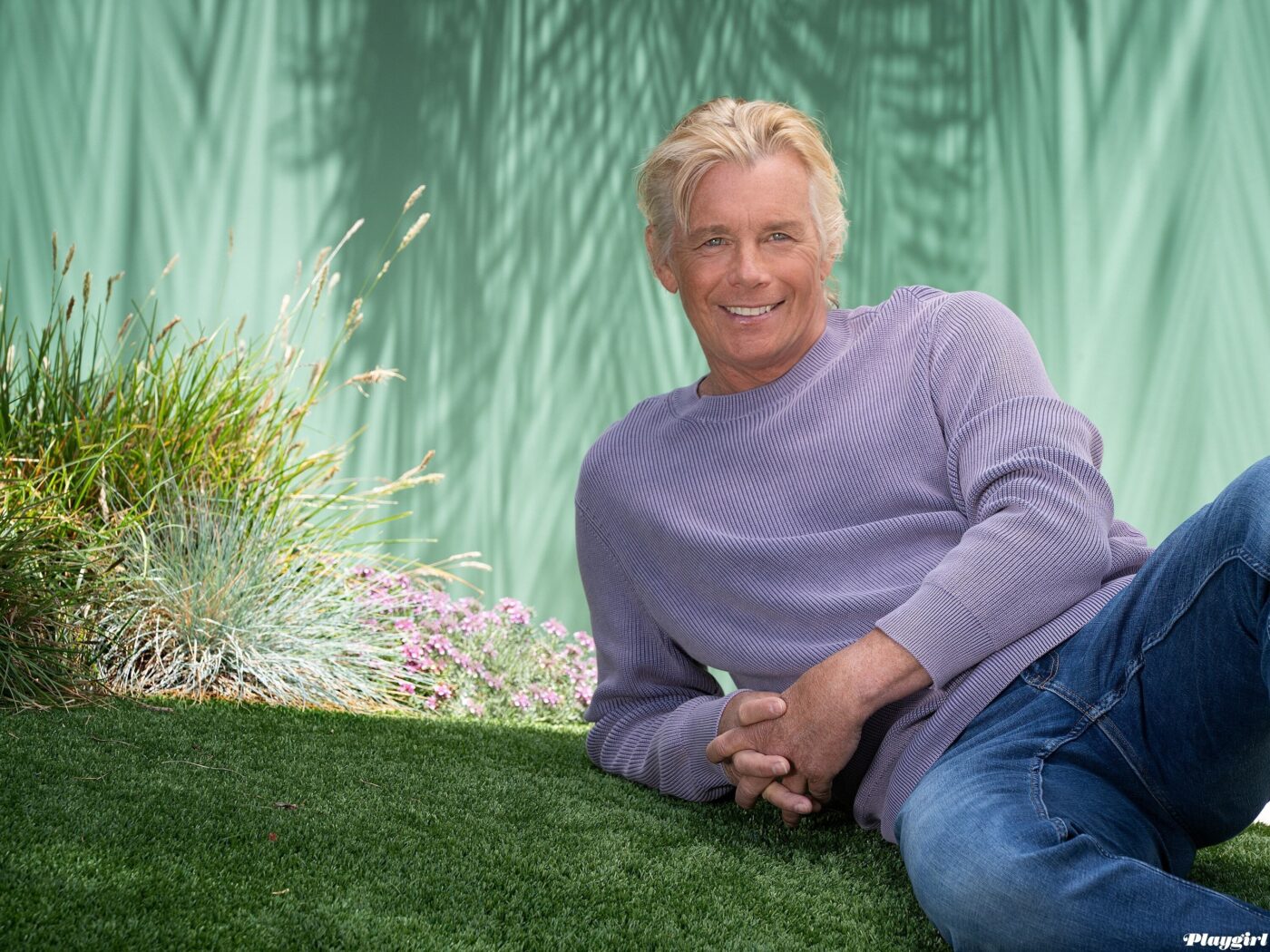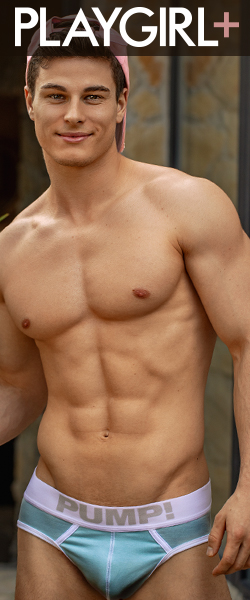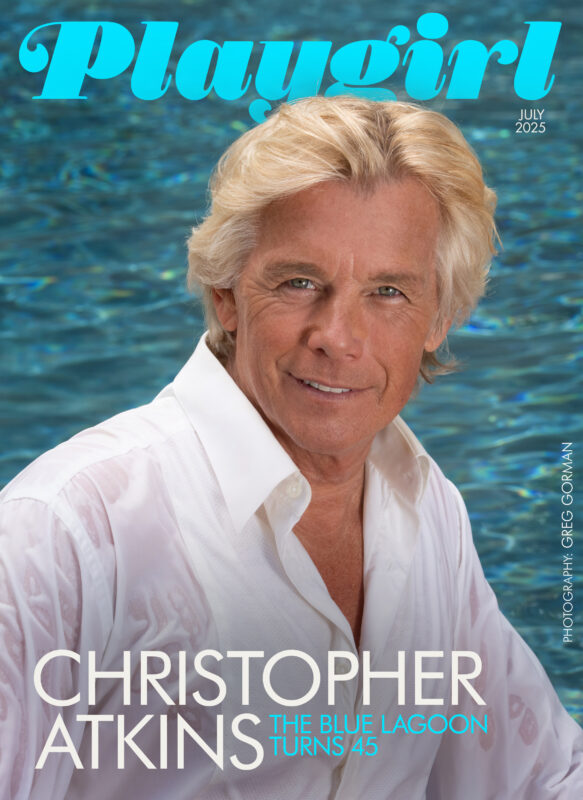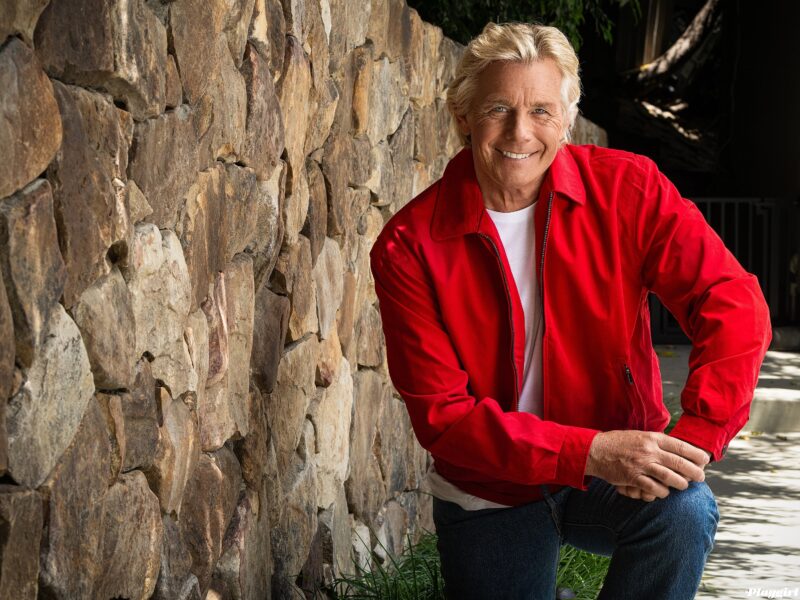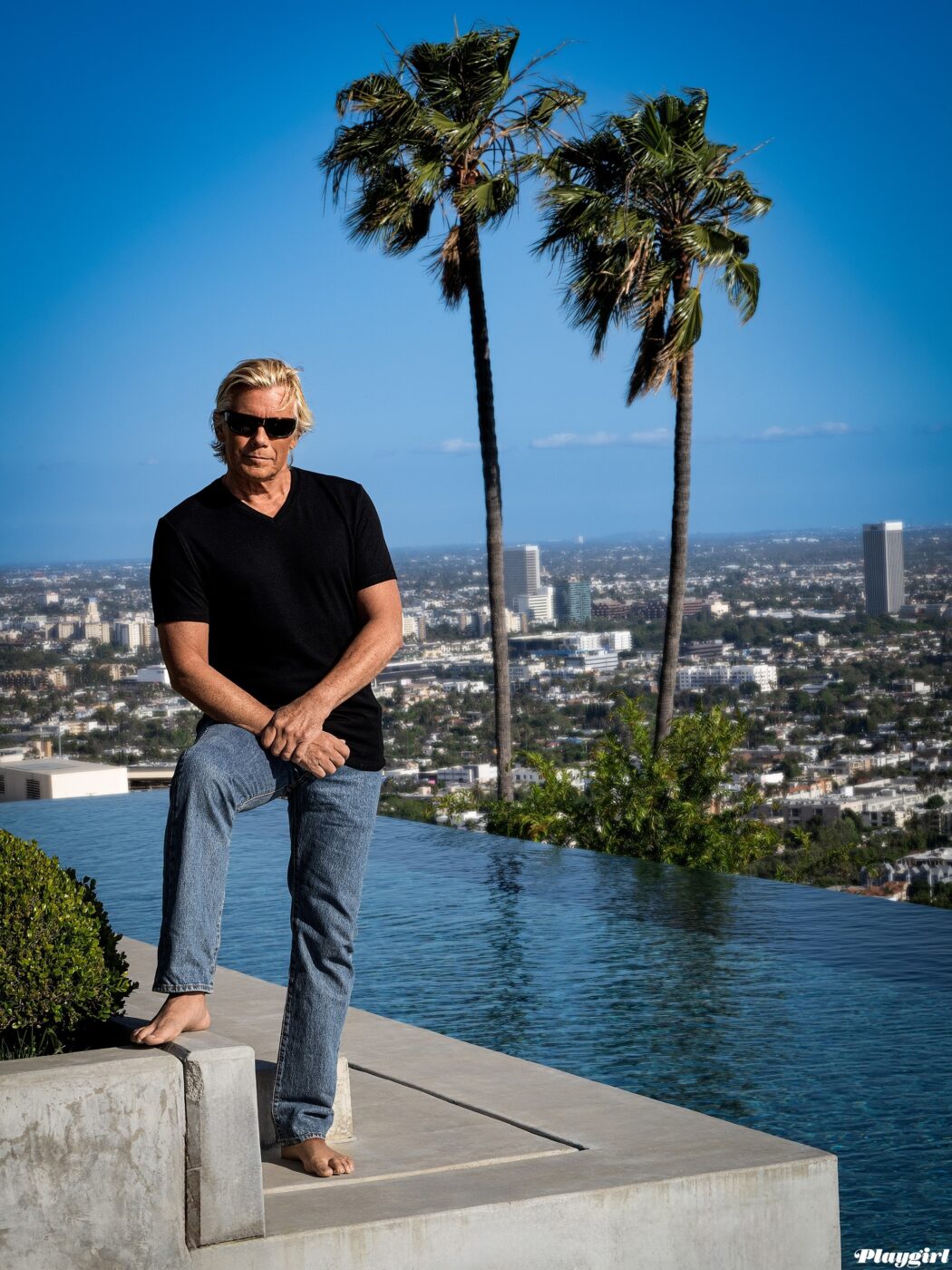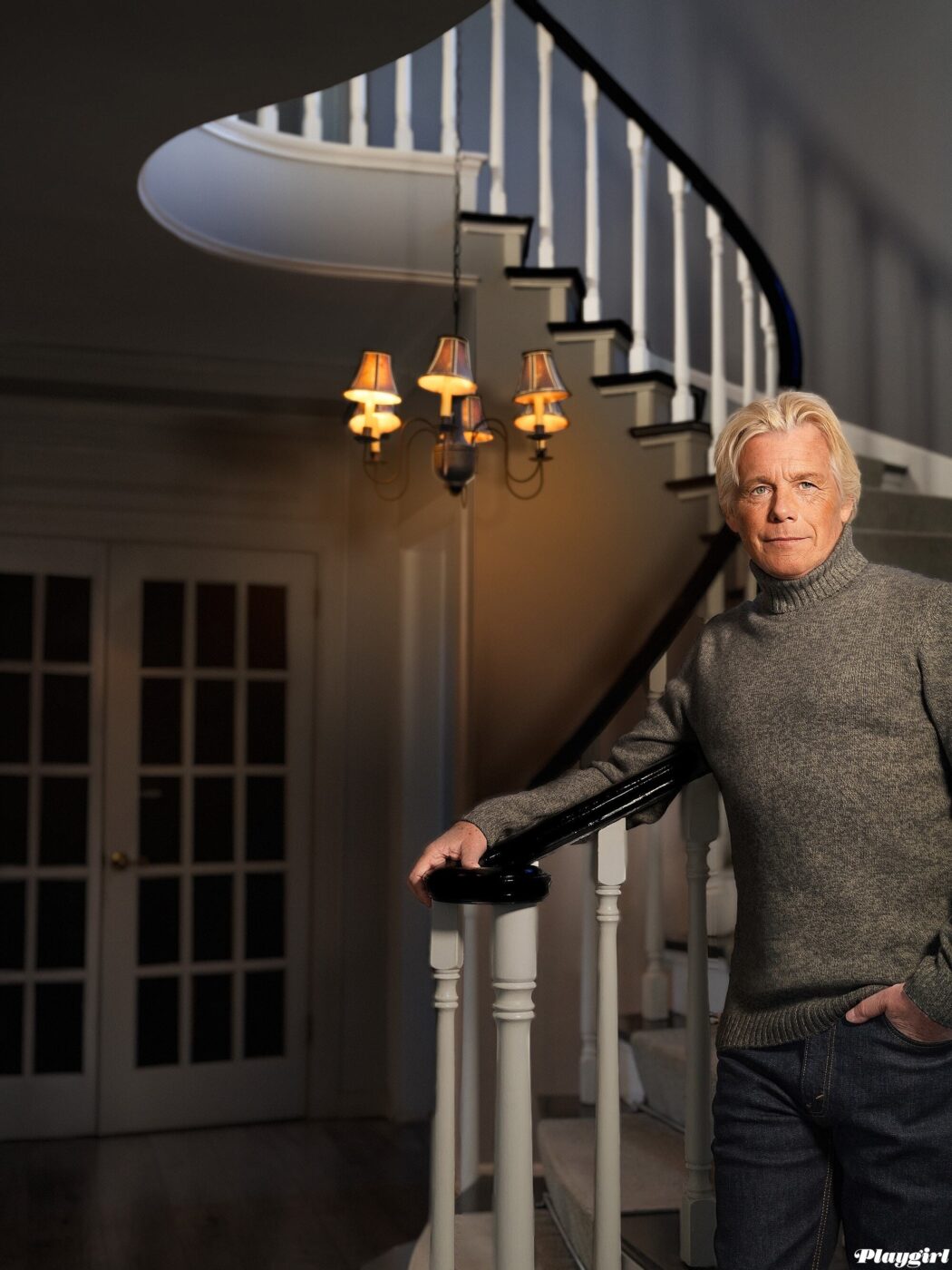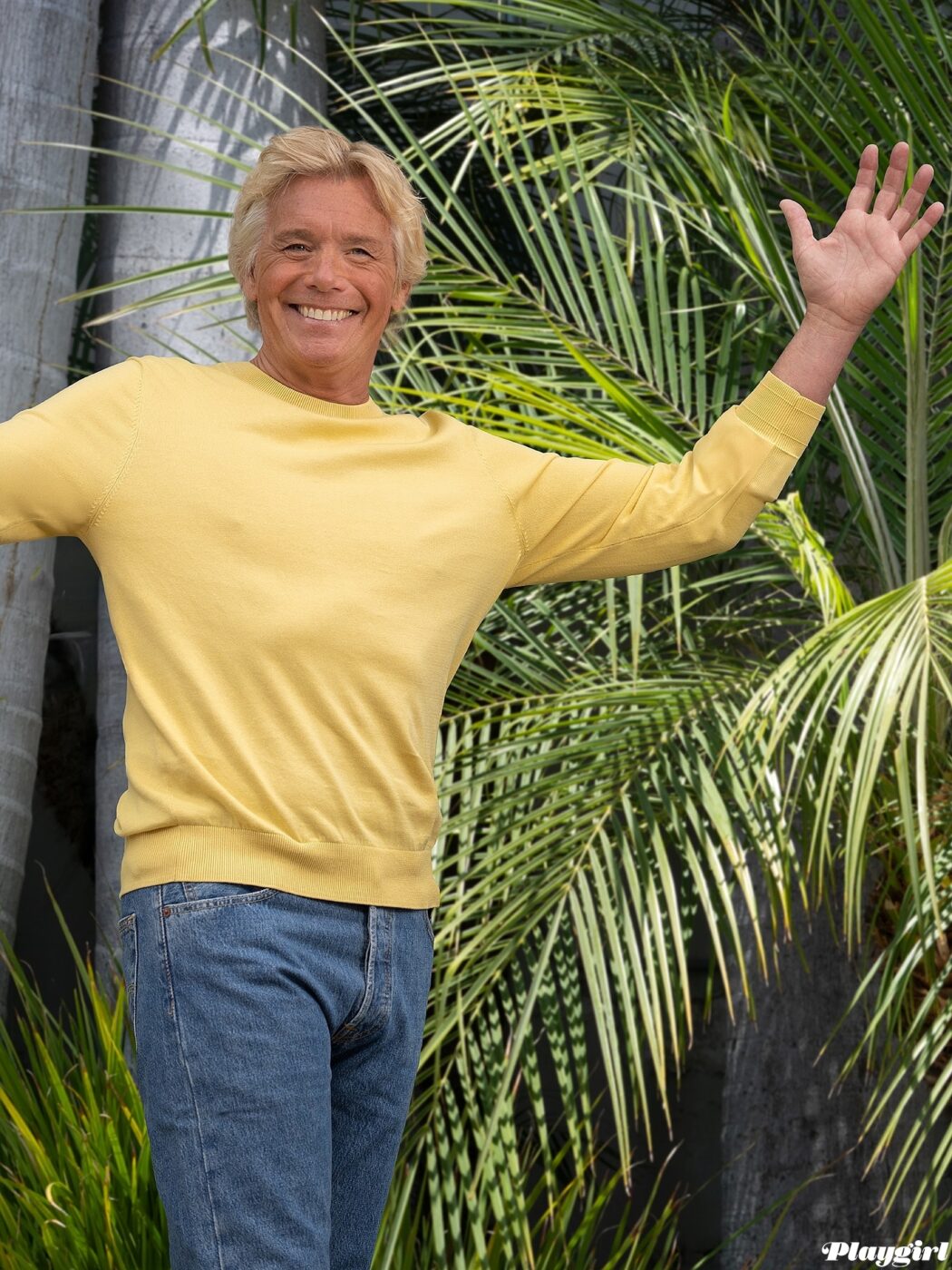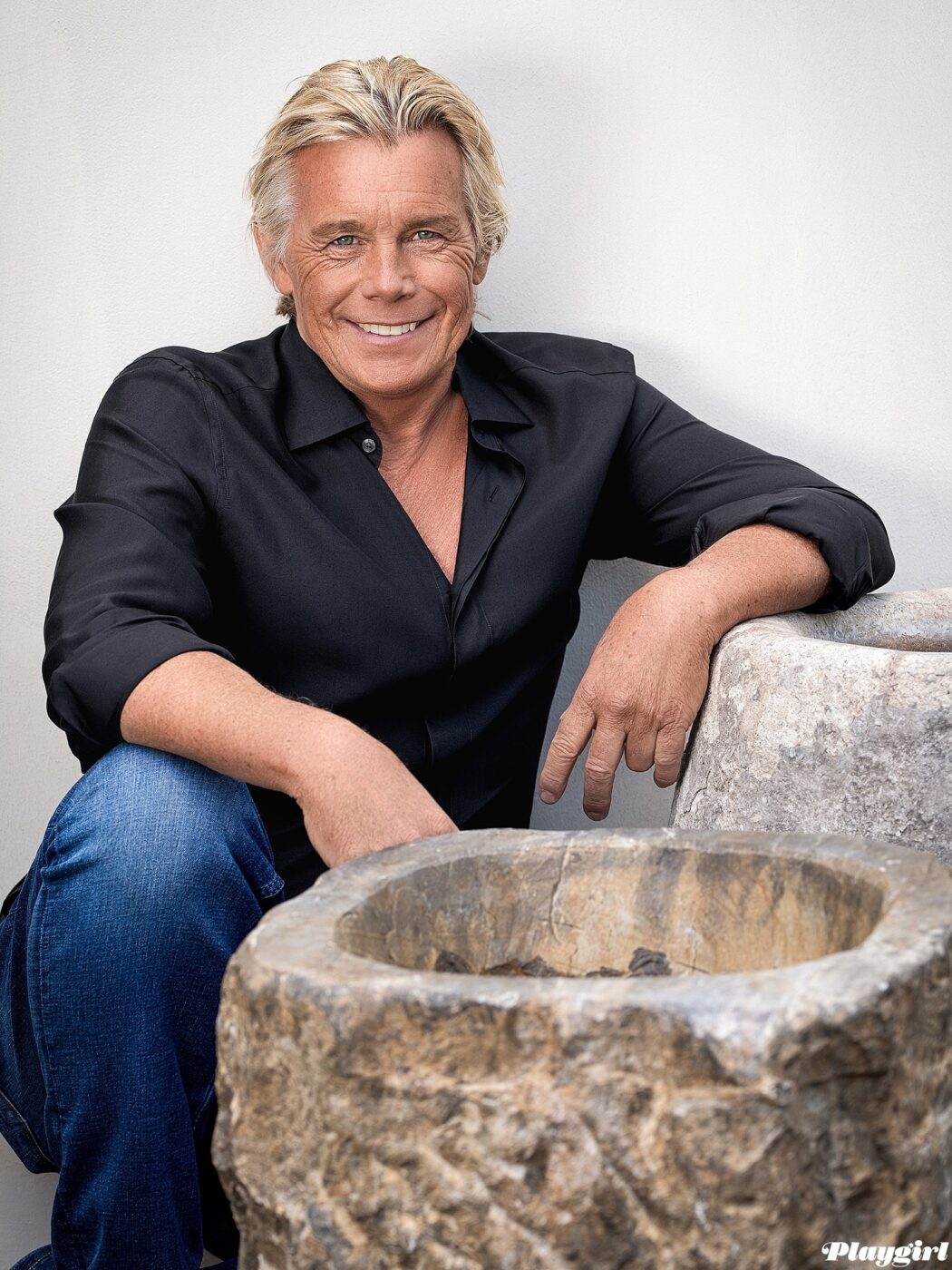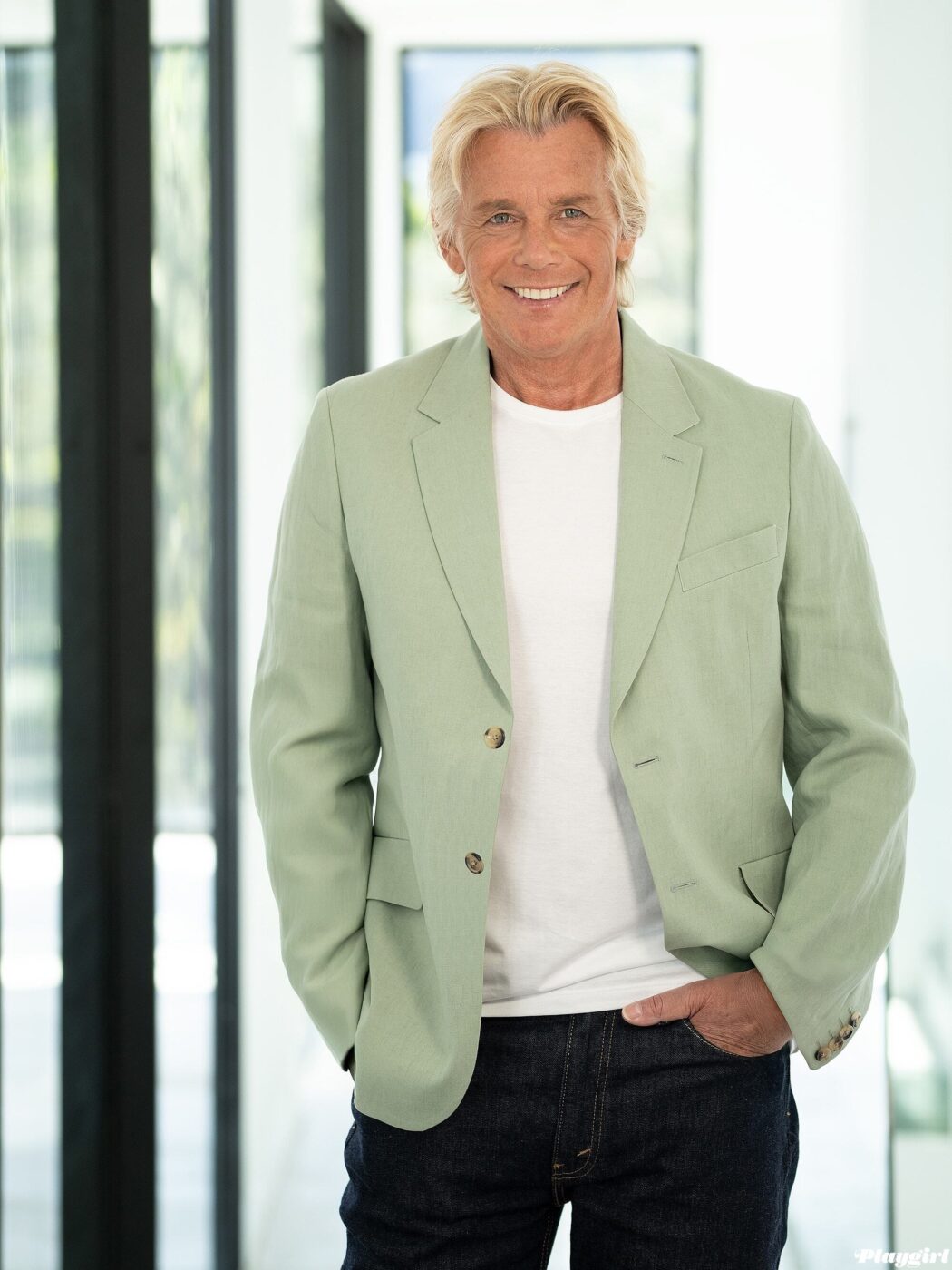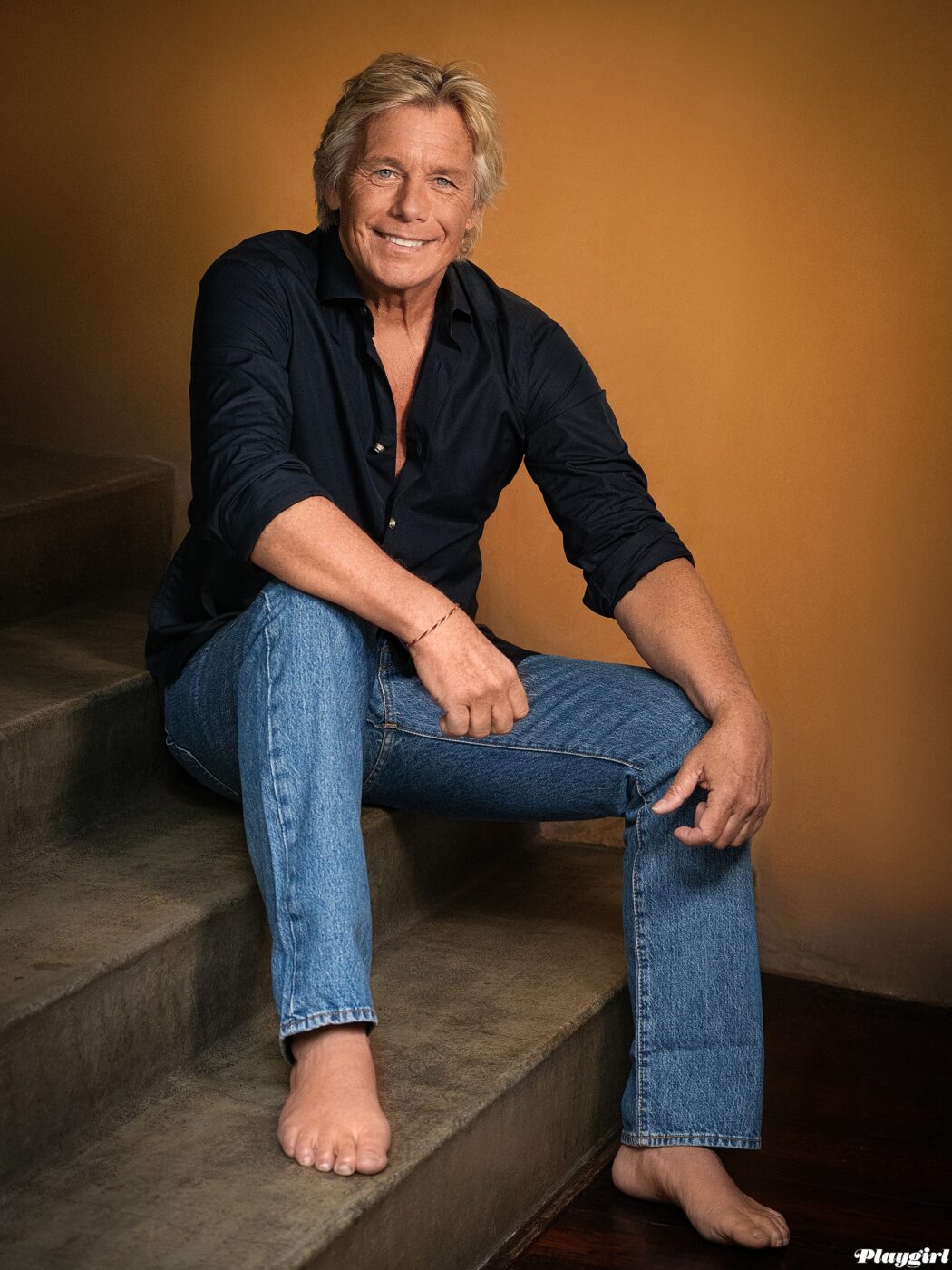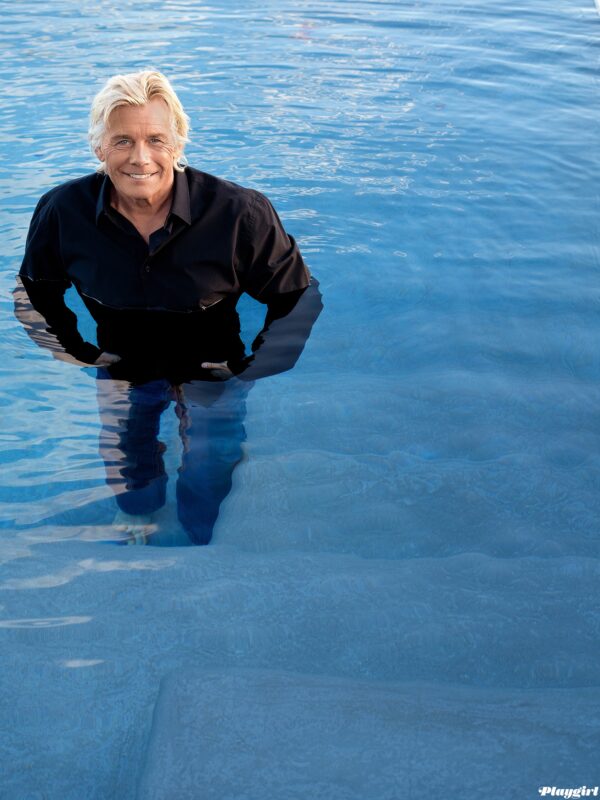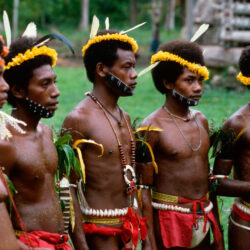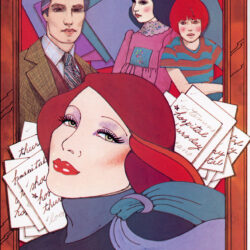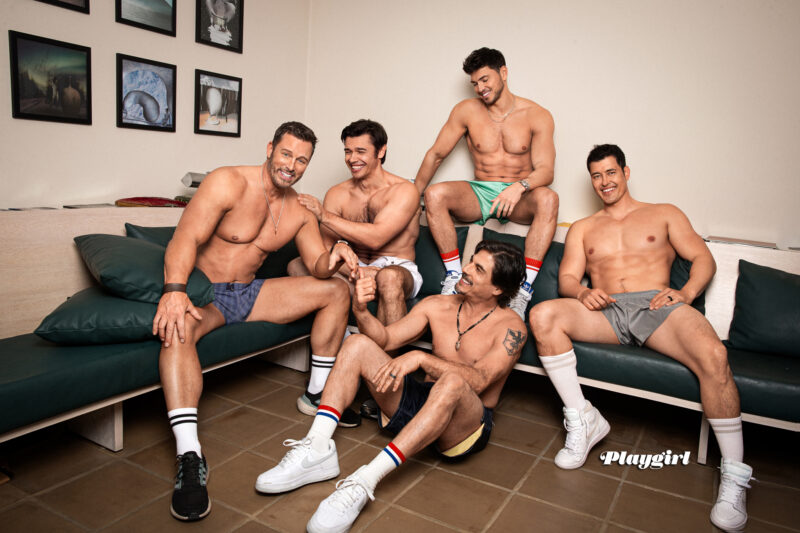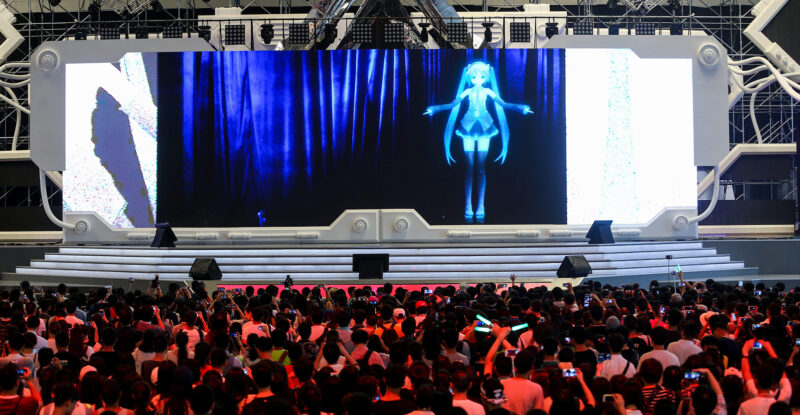7:30pm in West Hollywood. Legendary photographer Greg Gorman is in his car, exhausted. So is the crew, waiting for the gates to open. All of a sudden, Christoper Atkins pops out of the main door: He’s naked, with a towel wrapped around his waist. “Did you leave me any clothes?” he shouts. The stylist and the make-up artist look at each other and burst into laughter. No, we didn’t. We had left Atkins in the freezing cold pool where he agreed to Gorman’s ‘martini shot.’
The following morning, I meet with Atkins at a busy café in Studio City: His smile is infectious, his eyes sparkle with a youthful energy. On the agenda The Blue Lagoon’s 45th anniversary (it was released by Columbia Pictures in July 1980) and the way it celebrated –and normalized– male nudity. Because Atkins’ athletic body was eroticized no less than Brooke Shields’. And not in an arthouse film (Pink Narcissus), not in a European auteur film (Pasolini’s), but in a Golden Globe, Academy Award nominated studio production, which went on to gross 58 million domestically (despite the R rating) and as many worldwide. In more ways than one, The Blue Lagoon was the answer to Playgirl’s pursuit of equality: the dream of “opposing the double standard of expectation for women’s and men’s sexual expression.”
Here you are with straight hair, as we saw you in most of your movies –over 90 film and TV credits to date. And yet you’re known for the curly blond hair you had in The Blue Lagoon and The Pirate Movie.
[Laughs] Where did it go, right? Randal Kleiser, who directed The Blue Lagoon, always saw my character as a Greek adonis and that’s where the curly hair came from. Had nothing to do with me but after that movie everybody wanted me with curly hair.
Which explains The Pirate Movie.
Of course. I tell you, when those curls ended up falling out, I looked like Albert Einstein. It was awful.
The Blue Lagoon marked your first time making a movie and your first time out of the country, but it wasn’t your first time in showbiz. You got signed with the Ford modeling agency at 16: Tell us about those early days in fashion and the journey from modeling to auditioning for The Blue Lagoon.
I was teaching sailing to little kids at the American Yacht Club and one of the mothers took pictures of me and sent me into a modeling agency. They got me two jobs right away and it was just weird, because it was the last thing I would ever think in a million years that I would do. And I made more money doing those modeling gigs than I did all summer teaching sailing. So I thought, oh well that’s not too bad. Another person I had run into in New York knew Joey Hunter, who ran the male models at the Ford modeling agency. She said, “you know you should go in and see them.” I went, just for the hell of it. I end up in the women’s division and I’m sitting there with these incredibly long-legged, beautiful women, walking back and forth. Someone tells me, “Can I help you?” And I said yeah, I’m here to meet Joey Hunter and she says, “Go to the men’s division on the 3rd floor. But you look too young to be in the men’s division. When you’re done, come back here: I run the children’s division.” Her name was Claudia, she started the children’s division there, because of Brooke Shields. I got to see Joey and then I come back down and Claudia says, “well I have a go see –that’s what they were called back then– at JCPenney, if you’re interested.” So I walk over to JCPenney and I get pictures taken. I come back and Claudia said, “my God you got the job.” And that was with Lori Loughlin. Lori, Phoebe Cates, Lisanne Falk… we all modeled together back in the day in New York City and I did a thing for Seventeen magazine with Lori and Phoebe and Lisanne Falk and we all flew to Puerto Rico and shot all this stuff. And then the open call for The Blue Lagoon came. I went in and I thought to myself, well this would be kind of fun: when the movie comes out, I can tell all my buddies I read those lines… I was one of 4,000 kids.
How did Randal Kleiser direct you as a rookie with no experience in front of the camera?
I had just done a commercial before doing this. Literally the week before. But you’re right, I had no idea what a camera looked like. When they told me I got the picture I said no, I don’t want all that money on my shoulders [4.5 million USD], I don’t know what I’m doing. And they said no, no, we wouldn’t cast you, if we didn’t think that you could do it. I had this conversation with my mom and she said, “Well it’s something you don’t ever have to do again.” I said alright. They promised that it would all be done in time for me to go to college in Ohio and it never happened. [Randal] was just great, I mean he would say crazy things like “back in your cage,” because I’d be off doing something silly. I lived in a tent for 4 1/2 months on a deserted island: no movie was ever shot like that.
The third protagonist in The Blue Lagoon, in addition to you and Brooke, is the island itself and the way it was shot by legendary cinematographer Nestor Almendros, who got an Academy Award nomination for it. What do you remember about Nestor? Did he rely mostly on natural lighting?
He did and he was the funniest guy I’ve ever seen. He had coke-bottle-bottom glasses. I mean, they were the thickest damn glasses ever: I can’t tell you how many times I’ve seen him walk into a tree or something. But he was brilliant, brilliant with his natural lighting and he was just the most lovely man. It was not an easy shoot, you know. The Australians were the crew: it was rough. I mean, carrying equipment over rocks and beaches and all the rough terrain with no roads.
Readers who were not around in 1980 can hardly imagine the cultural phenomenon that The Blue Lagoon was. I’m 60: I was in junior high in Milano, Italy, and all kids talked about, for months, was you and Brooke Shields. You were 18 back then, you got nominated for a Golden Globe and got thrown into the limelight. How difficult was it for you to handle all that?
Well, it was more of an adventure. I always look at life as an adventure. I had no idea what was going to happen next and I had no idea my life would be completely changed overnight. But I have a really good family and good friends, you know. The hardest part is it’s impossible to be you, because everybody puts you on a pedestal and so when you’re around other people you’re on this pedestal and you have to deal with that public persona. At the same time, you still try to be grounded as you, you don’t want to lose yourself. It was a very interesting dynamic. There was not one place I could go on the face of this earth that I did not get recognized and there were times when I literally had my hair pulled, my shirt ripped off –I’m not kidding– and the police had to rush me out. Randal picked me up one day and he said, “let’s go see what the lions look like at the Dome” and we went across the street and we looked down and there was this 20 foot high cardboard cut-out of Brooke and me in the jungle and the line was a Star Wars line, it went all the way around the Dome down the street and around the block.
The curse and the blessings of being a teen idol. And a sex symbol.
They taped an interview not long ago and it was when Brooke had put out her documentary about being sexualized in the industry and we talked about me being sexualized and I said in the interview, well I was too. In every film I did, I had to show my ass, you know. I was sexualized, I said, but I liked it and the interview never aired, they wanted dirt. I didn’t have any problem with it. The interesting aspect to me was the gay aspect and how huge that fan base became. I can’t tell you how many times I’ve had people come on and that sort of stuff. And except for one time in San Francisco, people were usually very polite and nice and thoughtful and said what they felt and how the movie moved them and I was always very proud of that, proud of the fact that people could feel comfortable saying that. It means a lot. The only other negative side is that I got pigeonholed a little bit. But at the same time, I wouldn’t change anything, it’s just what it is. I’ve been blessed by some of the things that I got a chance to do. For instance, Columbia Pictures put me under contract for four years. That was kind of a big deal back then, the first time supposedly since the old MGM days that an actor was put under a studio contract. But they just didn’t do anything with it, I was sitting there waiting and waiting and waiting. 20th Century Fox bought me out to do A Night in Heaven and The Pirate Movie.
45 years later, and leaving behind some of the negative reviews of the day and the many controversies, what’s the place The Blue Lagoon secured in film history?
For sure this movie couldn’t be made today… and for many reasons.
“There is a gateway where our world ends and another begins,” says the original trailer: For me, The Blue Lagoon is Kleiser’s fantasy of a Paradise Lost, his visual ode to beauty, your beauty, Brooke’s beauty, the island’s (romanticized) beauty, the beauty of Poledouris’ lush score –and I think that’s what teenagers connected with.
It’s a Romeo and Juliet story: two kids destined to be together who couldn’t be together. That’s what’s so devastating about it. 50% of the public thinks we died, 50% thinks we didn’t. In The Garden of God, the second book, we died and the baby survived and my father who was searching for us, all these years, went loopy, took the baby back to the island to wait for our ghosts to come back.
It’s 1980, you and Richard Gere in American Gigolo made male nudity ‘mainstream.’ “He was every woman’s fantasy,” boasted the trailer of A Night in Heaven. But for gay men of the 80s you were also “every man’s fantasy.” You became the poster child of the gay rights movement –and not only in the United States.
I did an interview in New York and they asked me that question: do I know why I was so popular in the gay community, besides the obvious? In that time in history, they said, police and mayors and prominent people were coming out and it was a big thing to do and here comes this movie that celebrates male nudity. We kind of gave that poster boy to that community at a time when they needed the championing.
If you were to film today, you’d wear a prosthetic penis, sadly, and have an intimacy coordinator on set, especially for the love making scenes. What’s your take on intimacy coordinators?
I could teach them a thing or two. Do I need directions after all those movies with me naked and having sex?
You acknowledged you were sexualized and somewhat pigeonholed. In fact, you took your shirt off in the TV movie you filmed right after The Blue Lagoon. You were a stripper in A Night in Heaven and wore a sexy blue swimsuit in Dallas and…
Well, movies are visual. If I’m doing a movie and I’m moving you in some emotional way I’m doing my job, right? So if somebody is getting turned on, is liking what they see or whatever, I’m doing my job. And yes, sometimes it’s gratuitous, sometimes it’s over the top. Don’t worry, there is a point when they’re going to ask me to NOT take my shirt off.
Everyone knows you posed nude for Playgirl magazine. Then again, Shields posed for Playboy. When asked about it, you owned it: “hell yeah that was a good move: this whole business is about shock and awe, it was great.” In 2000 you stripped down again for photographer Greg Gorman and his coffee table book As I See it: let’s talk about Gorman and those two controversial shoots [three, with this latest one].
Greg has been a friend of mine since I was 18 years old. I don’t even remember how I met him and you know… he was nothing before he met me, I tease him. He’s one of the top three photographers in the entire world. After The Blue Lagoon and being naked on a deserted island, it’s just awful to be on a beach with a bathing suit –so, give me the nude beach. It’s one of the things that I enjoy, I still go to a nudist club in Connecticut: after a cold winter, I start dreaming about going to the club and relaxing. It’s not a sexual thing at all –I don’t I don’t know what to tell you, I just I enjoy it and it frees me up. Even Randal [Kleiser] asked me when we were flying to Fiji, “what about the nudity?” He was really nervous about it and it was a big deal in Blue Lagoon. I said, I don’t know, we’ll see when I get there. I just look at life as an adventure. He with the most stories wins because if you’ve got stories you’ve had adventure and if you’ve had adventure you’ve lived the life.
There’s a bit of a trend with your characters and older women: Linda Gray in Dallas, Leslie Ann-Warren in A Night in Heaven… Why do you think that is? Something about your ‘innocent’ good looks?
Let’s be honest about it. Blue Lagoon, male stripper… all of that kind of goes together. Also that was when I got bought out of the [Columbia] contract: I was still very hot, my name carried weight at the box office and so did Linda Gray’s. Greg [Gorman] shot the cover of US magazine with the two of us –it was everywhere. I was in the Bahamas and I’m walking through the casino and this old lady just stares at me. She comes right up to my face and she says, “you’re too young for her.” Yeah, it was shock and awe, you know: she was the first cougar, really, and it was massive. I was supposed to do a play on Broadway, The Rose Tattoo, with Gina Lollobrigida, and it was a big deal and that’s why I only signed one season with Dallas. Usually, you have to sign a minimum of two seasons, but they wanted to do it regardless and make a big deal about it. And boy it did –to this day I still get asked to all the Dallas reunions: it was that big of a controversial season.
Tell us about your marriage with Lyn. You married very young.
I was shooting The Pirate Movie in Australia and I was there for six months. I came home one day after work and I saw Playboy and it was the playmate of the year and I look at the centerfold and here’s this stunning girl on the beach and I read her bio and it said “favorite movie: Blue Lagoon.” I’m like, oh my gosh why can’t I meet a girl like this? Four years later I’m in Australia again and I’m shooting another thing and Lyn and another girl were filming for Playboy, I think. We all went out to dinner one night and I went with the sound guy to go get the girls and Lyn had her portfolio sitting on the bed and she wasn’t ready yet and I said, can I look at your book? So I’m looking at her modeling pictures and all of a sudden I get to this centerfold and I realize, oh my God you’re THAT girl. Six months later we’re married and we had two freaking awesome kids and I would say we had a pretty damn good marriage. She’s remarried now. My whole family took bets on how long that would last and I think my mom was the longest –three years. Well, it lasted twenty.
The Pirate Movie was not a success when it came out, but it has become a cult movie since.
I’ve got a gold album from my song in that movie and I tell my kids when we sing happy birthday and they’re like no dad, no, and so they pick on me all the time. I’ll never forget I was at the American Film Market one time and these people stopped me and said, hey you’re from… and I’m going, yeah. No, no The Pirate Movie, they said, and from that moment on I get more Pirate Movie autographs than Blue Lagoon: it’s huge. I think it’s just goofy enough and that the music is good music. People get caught up in it and they love it.
What’s next for Christopher Atkins, actor, producer and grandpa?
Well, besides messing with my kids and my grandchildren, my goal right now is to make my own picture. I don’t want to go through the Hollywood channels only because I’ve written things and then it goes on to the screen, but it gets taken away. I’ve done things for others for 40 years, I just want to be able to direct one picture. I’ve been very close with three projects. Really, really close –and it all comes down to money, you know: finding those investors that want to give me a shot and go make a really special film: I’ve been around the block, I’ve done movies, I have connections, I understand the business.
More images and the backstage video, exclusively on PLAYGIRL+
Also in this July special: Atkins’ 1982 interview, film theorist Lehman’s essay and sex therapist Waxman’s take on The Blue Lagoon.

